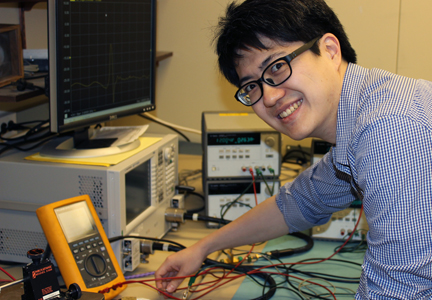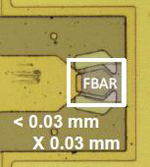Investigating a new material to help you stay connected
His final goal is to build novel RF circuits including frequency-selective switched oscillators based on his models.

 Enlarge
Enlarge
Seungku Lee, a graduate student in the Electrical Engineering program, received a U-M Rackham Predoctoral Fellowship to support his dissertation research on Large-Signal Modeling of Intrinsically Tunable and Switchable Ferroelectric FBARs for Frequency-Agile Communication Systems. This fellowship is awarded to outstanding doctoral candidates in the final stages of their program who are unusually creative, ambitious and risk-taking.
Seungku’s research focuses on large-signal modeling of ferroelectric BaxSr(1-x)TiO3 (BST) thin film bulk acoustic resonators (FBARs) for the design of reconfigurable radio frequency (RF) devices for modern wireless communication systems such as multi-standard frequency-agile smartphones. The resulting RF devices will permit significant reductions to the size, cost and complexity of current devices.
State-of-the-art communication devices like today’s smartphones and tablets require complex circuitry with numerous RF components including switches and filters. These are necessary for smartphones to operate under different communication standards (CDMA, GSM, LTE, etc) and to quickly switch between different types of RF signals.
“Our goal is to eliminate semiconductor switches by introducing intrinsically switchable and tunable components such as resonators and filters. BST FBAR-based RF devices would be significantly smaller, cheaper and less complex than current technology,” Seungku added.

 Enlarge
Enlarge
BST is a ferroelectric material whose properties can be altered with the application of an electric field. Seungku is pioneering the utilization of this intrinsic property to engineer tunable resonators, or ferroelectric bulk acoustic resonators (FBARs), that have an area smaller than 0.001mm2.
Using voltage to manipulate a thin layer of BST sandwiched between two electrodes, BST FBARs can select different bands without using conventional filters and switches. “This allows us to cut down on the number of components,” Seungku said. “We can just use these resonators and eliminate switches altogether.”
Seungku has already developed the very first large-signal circuit model for BST FBARs. “This is indispensable to the design of a new class of reconfigurable RF devices with the complete elimination of semiconductor switches and varactors within the radio front-end,” Seungku explained.
His final goal is to build novel RF circuits including frequency-selective switched oscillators based on his models.
Seungku Lee is advised by Prof. Amir Mortazawi, whose research is in the area of RF & Microwave circuits. Seungku received his B.S. and M.S. in EE from Yonsei University in Seoul, Korea.
 MENU
MENU 
